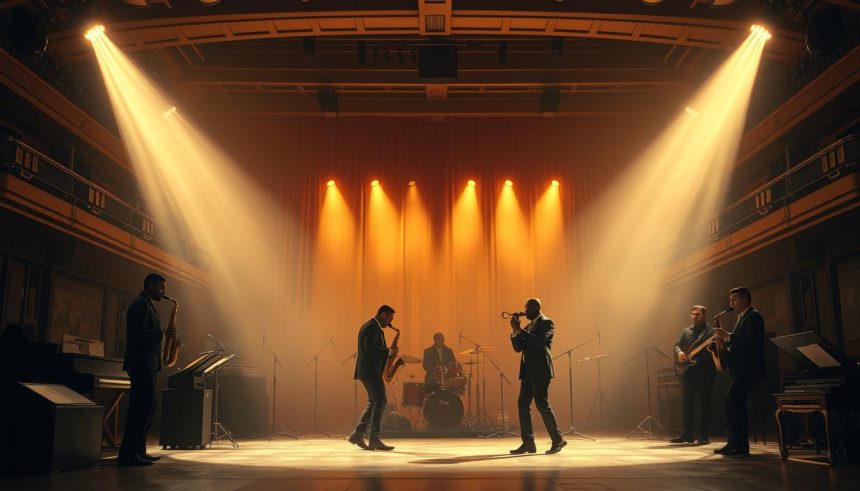Jazz’s best songs have changed the game, from smoky clubs to global hits. This list showcases the best jazz songs and timeless jazz hits that broke new ground. They’ve inspired countless fans and newcomers alike, blending creativity with deep emotion.
Each song on this list has made a lasting impact. They’ve shaped music history and culture. From swing’s lively beats to bebop’s intricate rhythms, jazz’s versatility is on full display.
Key Takeaways
- 100 songs that changed music’s DNA
- Stories behind jazz’s most famous recordings
- How these tracks influence today’s artists
- Legends like Miles Davis and Ella Fitzgerald featured
- A guide to understanding jazz’s evolution
Introduction to Jazz
Jazz emerged in the late 1800s, mixing African music with American creativity. It started in New Orleans, where jazz legends like Buddy Bolden and Jelly Roll Morton set the stage. This music brought together blues, ragtime, and brass band sounds, creating something unique.
A Brief History of Jazz
The genre grew in the early 1900s, spreading across the country during the Great Migration. Important milestones include:
- 1920s: Iconic jazz artists like Louis Armstrong and Duke Ellington made jazz famous worldwide.
- 1940s: Bebop, led by Charlie Parker and Dizzy Gillespie, raised the technical bar.
- 1950s-60s: Cool jazz and modal experiments, such as Miles Davis’ Kind of Blue, opened new creative doors.
Why Jazz Still Matters Today
Jazz’s spirit of improvisation and freedom continues to inspire. It influenced rock, hip-hop, and R&B, showing its lasting effect. Today, artists like Kamasi Washington and Esperanza Spalding mix old and new, keeping jazz alive. As Ella Fitzgerald once said,
“Jazz is the only music that’s never afraid of itself.”
This truth attracts both listeners and musicians to its spontaneity. Whether in cozy clubs or online, jazz’s rhythm lives on—a symbol of its eternal creativity.
The Foundations of Jazz Music
Jazz started with the deep feelings of blues and the upbeat beats of ragtime. These sounds mixed to create jazz’s improvisational heart. From New Orleans to the world, this journey made the classic jazz standards we love today.
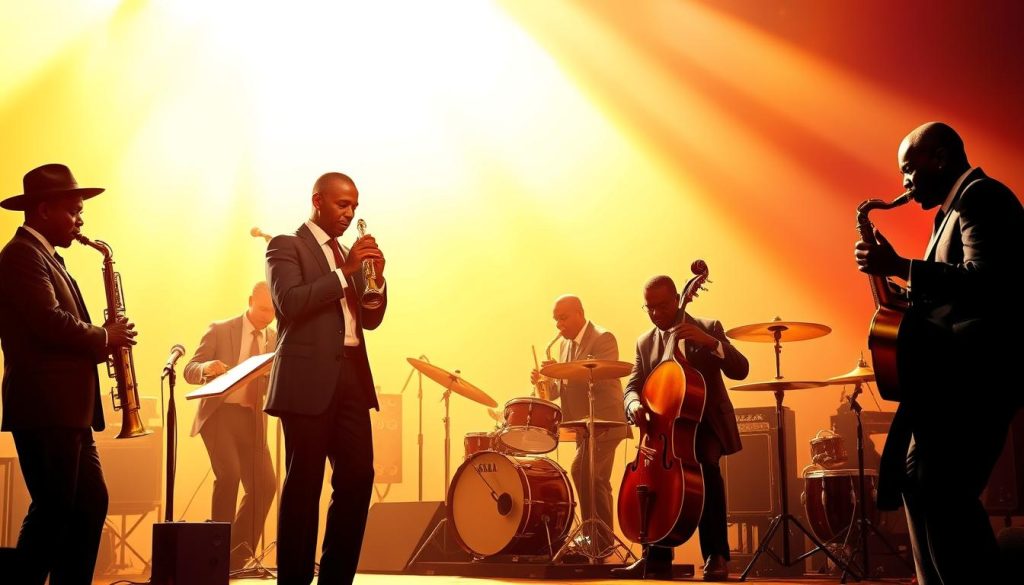
Origins in Blues and Ragtime
Blues music told stories with soul through 12-bar progressions and unique notes. Ragtime, with its syncopated piano, like Scott Joplin’s The Entertainer, brought complex rhythms. Early jazz mixed these, adding brass and group improvisation.
Tracks like King Oliver’s “Dippermouth Blues” showed this mix. They created the first greatest jazz songs ever.
Key Jazz Styles Over the Decades
Jazz’s story is told through different eras:
- Swing (1930s–40s): Big bands like Count Basie’s orchestra filled dance halls. Benny Goodman’s “Sing, Sing, Sing” was a key song.
- Bebop (1940s): With faster tempos and complex melodies, creativity soared. Charlie Parker’s “Ko-Ko” changed improvisation.
- Cool Jazz (1950s): Miles Davis’ Birth of the Cool sessions brought calm harmonies. Tracks like “Moonlight in Vermont” mixed warmth with new ideas.
- Free Jazz (1960s): Ornette Coleman’s “Free Jazz” broke rules, opening new paths.
Each era gave us classic jazz standards that artists still play today. From swing’s energy to bebop’s complexity, jazz’s evolution keeps it fresh.
Influential Jazz Artists to Know
These jazz legends changed music forever. They left us with songs that still touch our hearts today. Their work has shaped jazz into what it is now.
Louis Armstrong
Louis Armstrong changed jazz with his trumpet. He mixed skill with feeling in songs like “West End Blues”. His voice, heard in “What a Wonderful World”, is unforgettable.
He made jazz more than just a group sound. It became a place for solo artists to shine.
Miles Davis
Miles Davis was a musical pioneer. His album Kind of Blue introduced modal jazz. It featured hits like “So What”.
He kept jazz fresh by trying new things. His work is a key part of jazz history.
Ella Fitzgerald
Ella Fitzgerald’s voice was amazing. She could mimic instruments with her scat singing. Her versions of “A-Tisket, A-Tasket” and other songs are classics.
Her skill and feeling set a high bar for singers. She showed the world what a great vocalist could do.
John Coltrane
John Coltrane explored new sounds on his saxophone. His music, like “Giant Steps” and “A Love Supreme”, took jazz to new places. His passion and curiosity opened up jazz’s possibilities.
The 100 Best Jazz Songs of All Time
Choosing the best jazz songs means finding a mix of old and new. Our list of top 100 jazz tracks features songs that have shaped jazz over time. Each song is a tribute to musical greatness, cultural significance, and lasting impact.
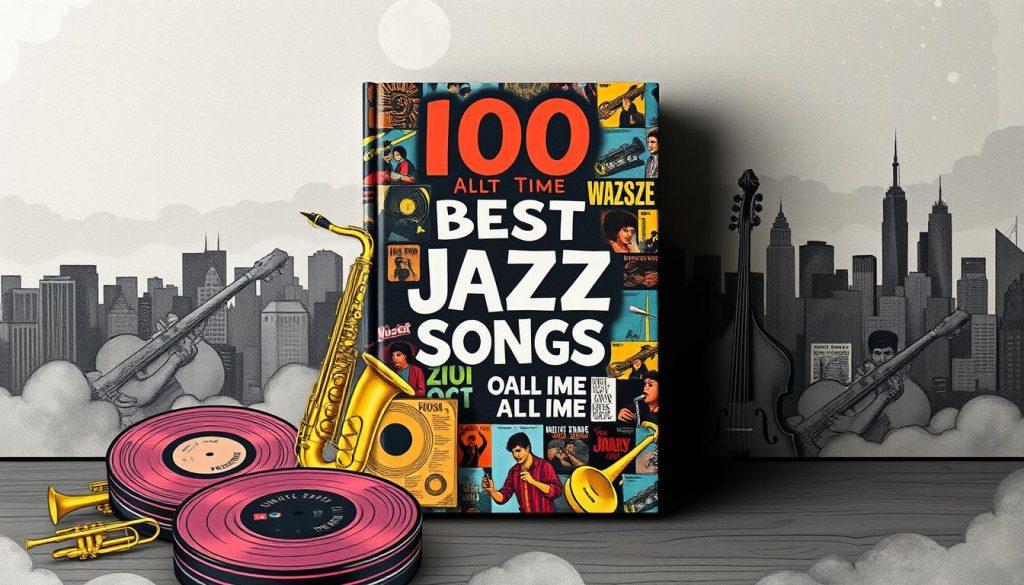
How We Chose These Songs
We looked at technical skill, historical importance, and how well they connect with listeners. We picked songs that pushed jazz’s limits, like Take Five (Paul Desmond, 1959) and So What (Miles Davis, 1959). We made sure to include a variety of styles and eras.
The Definitive Top 100 List
Here are some highlights from our full list:
- Take the A Train (Duke Ellington, 1941) – A classic from Harlem that showed the power of big band music.
- Round Midnight (Thelonious Monk, 1944) – A song that shows Monk’s unique and bold style.
- My Favorite Things (John Coltrane, 1961) – A song that changed vocal jazz with its bold improvisation.
And 97 more songs that cover 120 years of jazz history. Each song has a detailed review in our full guide.
Every top 100 jazz tracks song is a mix of talent and appeal. Whether you’re new to jazz or a long-time fan, this list is a journey. Explore the full list to see why these songs are jazz’s foundation.
Must-Hear Albums Featuring These Songs
Legendary jazz albums turn standout tracks into full artistic visions. These picks rank among the best jazz albums. They show how timeless jazz hits gain depth when heard in their original context.
Kind of Blue – Miles Davis
Released in 1959, this modal jazz breakthrough features So What and All Blues from our top 100. The album’s relaxed yet profound mood reshaped music history. Its simple scales let Davis’s band explore freely, proving innovation can come from restraint.
A Love Supreme – John Coltrane
A Love Supreme blends spiritual themes with Coltrane’s intense saxophone. The title track and Venue from our list highlight its four-part suite structure. This album’s emotional intensity made it a landmark of jazz expression.
Time Out – The Dave Brubeck Quartet
Brubeck’s 1959 album broke rules with odd time signatures. Take Five (in 5/4 time) and Blue Rondo à la Turk (in 9/8) became hits. Its mix of complexity and catchiness made jazz accessible to millions.
Albums like Birth of the Cool and Kind of Blue’s legacy shows why context matters. Dive into these collections to hear how timeless jazz hits fit into larger artistic statements.
What Makes a Great Jazz Song?
Every legendary jazz song has a special mix of art and skill. It’s not just about the music—it’s about feeling, creativity, and the magic of the moment. This magic turns inspiration into something unforgettable. Knowing these elements helps you create a jazz music playlist that truly captures jazz’s essence.
The Role of Improvisation
Improvisation is jazz’s lifeblood. It’s when a musician changes a melody live, making each performance unique. Look for solos that add new twists to a theme, like a saxophonist’s emotional bends or a pianist’s surprising runs. These moments show that even with rules, there’s always room for freedom.
The Importance of Innovation and Expression
Great jazz mixes technical skill with deep feeling. Tracks that stand the test of time, like those on our famous jazz songs list, often break the mold while staying true to their human side. Think of Miles Davis’ Kind of Blue sessions, where new ideas in jazz didn’t lose their emotional edge. Without heart, innovation is empty; without skill, expression is lost.
“Don’t play what’s there, play what’s not there.” —Ella Fitzgerald
Creating a jazz music playlist that showcases these qualities? Seek out tracks where musicians:
- Transform repetition into something new (notice variations in solos)
- Mix old styles with fresh ideas (like combining swing with modern beats)
- Let passion lead their technical abilities
By spotting these traits, you’ll see why some songs become classics while others fade away.
Jazz Standards and Their Legacy
Jazz standards are timeless songs that shape the genre’s soul. Classics like “Body and Soul” and “Round Midnight” have been reimagined by many artists. They are the heart of jazz, connecting past and present.
What Is a Jazz Standard?
These songs are loved by many musicians over the years. They started as pop hits or Broadway tunes, like “Autumn Leaves.” Jazz standards let artists add their own twist while staying true to tradition.
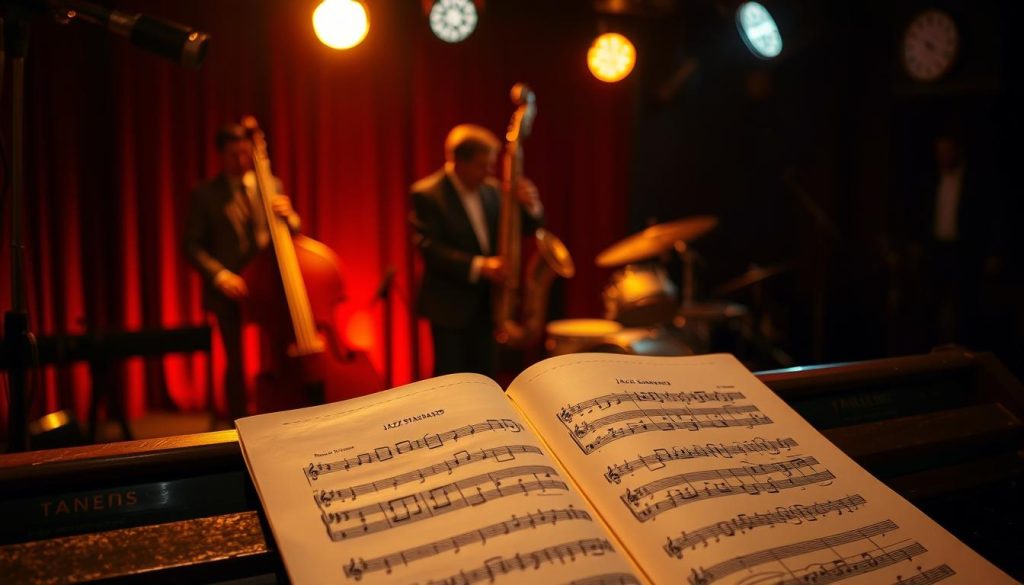
Most Covered Jazz Standards in History
- Body and Soul: Recorded over 2,000 times. Coleman Hawkins’ 1939 version and Miles Davis’ 1951 take are among the best jazz songs.
- Round Midnight: Thelonious Monk’s song has inspired many, with Bill Evans’ 1963 album being a highlight.
- Autumn Leaves: Its French origins turned it into a jazz favorite, known for its improvisation-friendly chord changes. It’s a staple in jazz.
These classic jazz standards stand the test of time. They offer a canvas for artists to express themselves, keeping jazz alive.
Contemporary Jazz and the Modern Sound
Today’s jazz scene is a mix of old and new. Modern artists pay tribute to jazz legends while exploring new sounds. They create jazz songs for beginners and fans of all levels.
Notable Modern Jazz Artists
- Kamasi Washington – He combines jazz with hip-hop, featured in Black Panther.
- Esperanza Spalding – A bassist who blends R&B and soul, winning a Grammy in New York Times.
- Robert Glasper – He connects jazz and hip-hop, working with Kendrick Lamar.
How Jazz Is Evolving Today
Technology and global influences are changing jazz. Apps like Soundtrap let artists mix sounds. Christian Scott aTunde Adjuah combines West African beats with jazz.
Streaming platforms make jazz songs for beginners more accessible to everyone.
| Modern Artist | Inspiration | Signature Style |
|---|---|---|
| Kamasi Washington | John Coltrane | Orchestral Fusion |
| Esperanza Spalding | Ella Fitzgerald | Vocal Bass Innovation |
| Robert Glasper | Thelonious Monk | Hip-Hop Jazz |
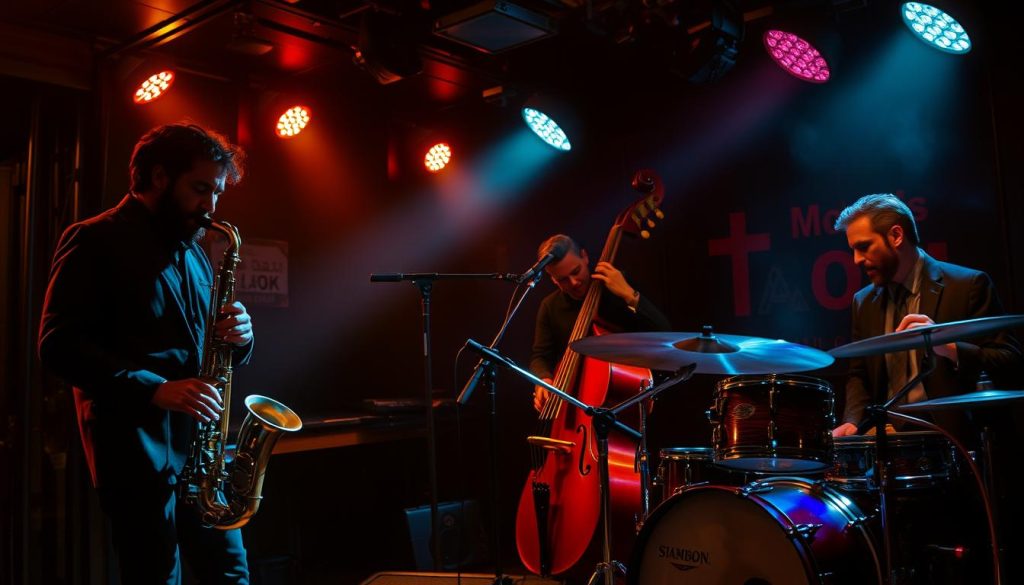
“Jazz is a conversation between past and present.” – Kamasi Washington
Exploring these artists’ work is a great way to dive into jazz’s legacy. Start with Spalding’s “Junjo” or Glasper’s “Black Radio”. They offer modern takes on timeless jazz.
Build Your Own Jazz Playlist
With the top 100 jazz tracks and knowledge of jazz’s history, making your own jazz music playlist is exciting. Pick songs that match your mood or the event. This guide will help you every step of the way. These songs offer a wide range of options for any moment.
Tips for Creating a Balanced Jazz Mix
Start with a theme, like “high-energy bops” or “cool ballads.” Then, mix old and new. Include classics like Miles Davis’ Kind of Blue and modern takes. Balance vocals, like Ella Fitzgerald, with instrumental geniuses like John Coltrane.
Think about the flow: begin softly, then get louder, or surprise with a change. This makes your playlist engaging.
Mixing Eras, Artists, and Moods
Try different themes, like “Jazz for Focus” with Thelonious Monk or Dave Brubeck’s Take Five. For a “Nighttime Mix,” mix Coltrane’s A Love Supreme with Billie Holiday’s songs. Mix fast and slow to create contrast.
The top 100 jazz tracks have everything you need. Start exploring, try new things, and let these songs lead you through jazz’s vast world.

